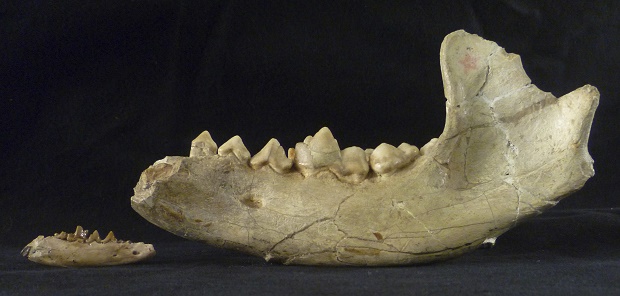‘Beardog’ discovery offers clues to how canines evolved

This undated photo provided by Susumu Tomiya and The Field Museum in Chicago shows the lower jaw of a birddog, left, and is about 16 million years old. In comparison, the bigger beardog jaw is about the size of the modern black bear’s. For decades the two sets of fossilized carnivore jaw bones sat in a drawer in the museum, largely unnoticed. Now the scientist who grew curious about them has established with a colleague that that the fossils belonged to an early, long-extinct relative of dogs, foxes and weasels known as beardogs. AP
For decades a fossilized carnivore jawbone sat largely unnoticed in a drawer at Chicago’s Field Museum.
Now the scientist who grew curious when he opened that drawer has established with a colleague that the fossil belonged to an early, long-extinct relative of dogs, foxes and weasels known as a beardog. The Field Museum fossil and another at the University of Texas each represent a new genus, the taxonomic rank above species.
The researchers believe these beardogs, which lived up to 40 million years ago, may eventually tell the world more about the evolution of dogs and other carnivores and how animals adapt to changes in climate.
According to a paper to be published Wednesday in the journal Royal Society Open Science, the jawbones belonged to two closely related types of Chihuahua-sized beardogs, new genera now named Gustafsonia and Angelarctocyon.
The Field Museum fossil set off the research by post-doctoral researcher Susumu Tomiya, who works at the museum and spends much time taking care of its large collection of fossils.
“In my spare time I like to walk around the aisles in the collections and open up drawers,” he said. “One day I just stumbled on these interesting-looking jaws of a little carnivore.”
The fossil was discovered in Texas in 1946 and 30 years ago was loosely classified as some type of carnivore. But no one knew where it fit into the carnivore family, said Tomiya, who authored the paper with Jack Tseng of the State University of New York at Buffalo.
The teeth stood out to Tomiya. They had flatter surfaces for crushing that suggested their owners ate more than meat — maybe berries and bugs, too, like present-day foxes.
The teeth reminded Tomiya of beardogs he was familiar with, he said. But the types of beardogs he knew were much larger predators that were the size of a bear and once roamed parts of North America, Europe, Asia and Africa.
The researchers also compared the fossil with one written about in an earlier paper at the University of Texas. Tomiya and Tseng concluded both belonged in what had essentially been a blank spot in the branch of the mammalian tree that includes dogs, raccoons, weasels and similar animals. Beardogs evolved alongside the ancient cousins of present-day dogs, cats, bears and other carnivores.
The evolution of beardogs from the small varieties classified by Tomiya and Tseng to the much larger animals that needed more food and habitat seems to match evolutionary paths of other animals that led to extinction, Tomiya said. Beardogs were extinct by 5 million to 10 million years ago, he said.
Studying how the diversity of beardogs waxed and waned over time could tell us about larger patterns in carnivore evolution,” he said.
The two genera of small beardogs also lived at a time of climate transition in North America, from subtropical to cooler and relatively dry. Further study could help answer questions about what kinds of animals adapted well to that change, Tomiya said.
The new research is interesting in part because the fossils were found in North America, said Steven Wallace, a geosciences professor at East Tennessee State University and curator at the East Tennessee Natural History Museum.
Beyond that, Tomiya and Tseng’s work is a reminder to scientists that discoveries don’t just come from fresh digs in far-flung locales.
“It’s almost like they feel that once a specimen’s been described, they’ve learned everything they can from it,” Wallace said. “Sometimes the coolest discoveries come right out of a museum.”
RELATED STORIES